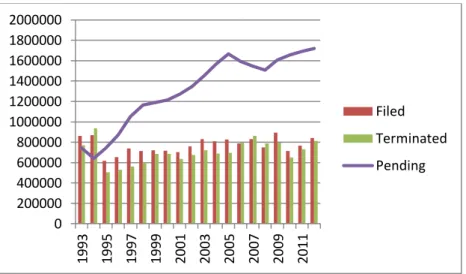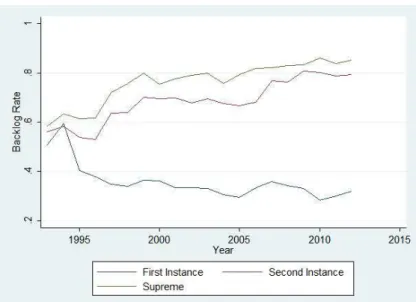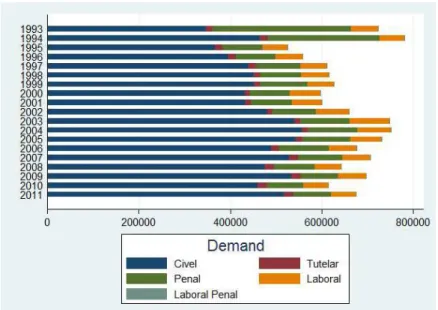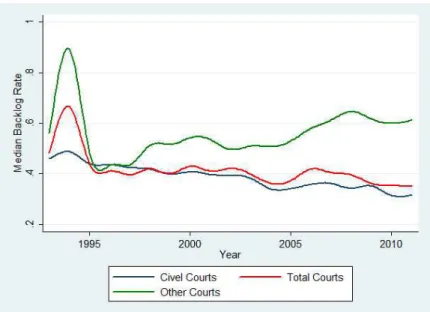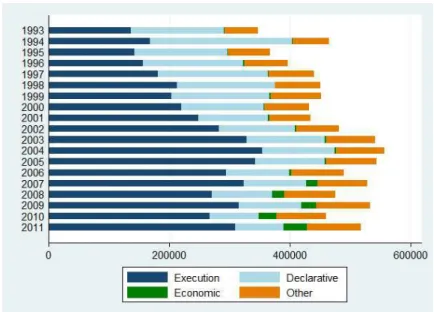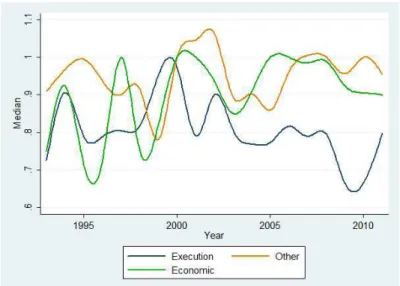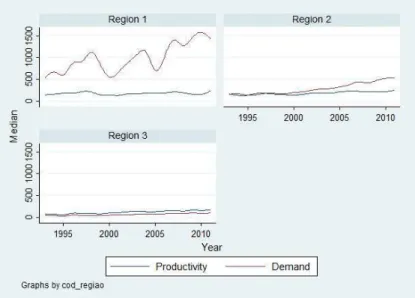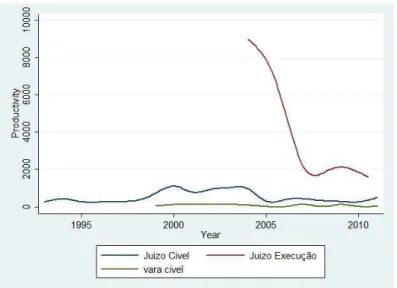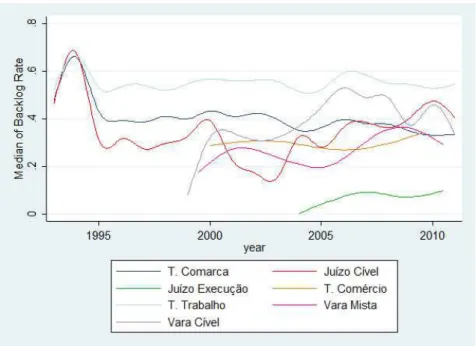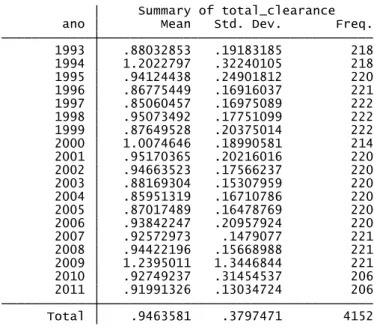M
ASTER
M
ONETARY AND
F
INANCIAL
E
CONOMICS
M
ASTER
D
ISSERTATION
The Portuguese Judicial System: Descriptive enquiry on
problems faced and a model for productivity
D
IOGO
F
RANCISCO
S
AMPAIO
L
IMA
M
ASTER
M
ONETARY AND
F
INANCIAL
E
CONOMICS
M
ASTER
D
ISSERTATION
The Portuguese Judicial System: Descriptive enquiry on
problems faced and a model for productivity
D
IOGO
F
RANCISCO
S
AMPAIO
L
IMA
O
RIENTATION:
M
ANUELC
OUTINHOP
EREIRA,
B
ANCO DEP
ORTUGALA
NTÓNIOA
FONSO,
I
NSTITUTOS
UPERIOR DEE
CONOMIA EG
ESTÃO1
The Portuguese Judicial System: Descriptive enquiry on problems faced
and a model for productivity
By Diogo Lima1
Instituto Superior de Economia e Gestão, Universidade Técnica de Lisboa
Department of Economics, Indiana University
Supervisor: Manuel Coutinho Pereira
Banco de Portugal
António Afonso
Instituto Superior de Economia e Gestão
30th September 2013
1
2
Abstract
There seems to be a wide agreement in Portuguese society that the legal system is one of the main structural problems and one reason for the anemic economic growth experienced in recent years. The objective of this paper is twofold. First, it offers a view on the state of the Portuguese judicial system over the past two decades and contributes with a perspective on the reasons Portuguese justice can be perceived as a roadblock on economic development. Second, it goes further and tries to explore potential answers by constructing an econometric model that o e ts judge’s p odu ti it ith its pote tial determinants. Furthermore, this econometric model also deals with endogeneity issues not dealt with in similar studies.
JEL Codes: K40, P37
3
Contents
1. Introduction ... 4
2. Sketch and evolution of the Portuguese judicial system ... 7
2.1. The Portuguese Judicial system ... 7
2.2. Evolution of the Portuguese judicial system ... 9
3. The Portuguese Judicial System for 1993 to 2911: Key indicators ... 13
4. Panel estimation ... 24
4.1 The Data ... 25
4.2 OLS model ... 26
4.1.1 OLS Results ... 29
4.2 Two-way Fixed effect model ... 29
4.2.2 Two-way FE Results ... 31
5. Conclusion ... 33
References ... 35
Appendix I ... 37
4
1. Introduction
Portugal is seen as having a legal system below European standards (Tavares (2004)). It would take more than two years of court work to deal with the amount of work unfinished in past years, and this is due to a deficit in the ability to supply an amount of justice enough to meet the demand (that is, the number of filed files have almost always surpassed the number of finished files).
Figure 1: Portuguese judicial system
“ou e: DGPJ a d autho ’s al ulatio s
The negative impact of the number of pending files in judicial courts can be very troublesome. For instance, in Portuguese courts, it takes almost two times as many days to collect a check returned for nonpayment than the average court in Djankov et al. (2003) study (441 against 234 days). Moreover, there is a wide agreement in Portuguese society that the legal system is one of the main structural problems and one likely reason for the anemic potential economic growth. Justice is perceived by economic participants as being slow and uncertain. Companies with less contact with
5
the judicial system define it has been a huge hurdle for business activities (Fundação Francisco Manuel dos Santos (2013))2.
A proper working judicial system can be of the highest degree of significance to a e o o ’s pe fo a e. Fi st, o l a sou d judi ial s ste a ensure the enforcement of property rights, and this fact has enormous consequences on the investment decisions both domestic and international. Second, not only investment is affected, every exchange of goods and services relies on an environment where contracts are properly protected by law. If the judicial system is an obstacle to the free exchange between economic agents, it is imposing an unnecessary friction to the economy.
Already Adam Smith recognized the link between justice and economic growth: Little else is e uisite to a a state to the highest deg ee of opule e […], ut pea e, eas ta es, a d a tole a le ad i ist atio of justi e… (Smith (1755)). Recent works have also established a connection between the legal system and economic development (see Glaeser et al (2004)). Moreover, Tavares (2004) finds evidence supporting the need to reform the Portuguese legal system in order to create growth stimulus.
The objective of this paper is twofold. First, it offers a view on the state of the Portuguese judicial system over the past 20 years and documents the reasons Portuguese justice can be perceived as a roadblock on economic development. Second, it goes further and tries to explore potential answers by constructing an
2
6
econometric model that connects judge’s productivity with its potential determinants. The innovative feature is the use of a richer and flexible database and the ability to tackle endogeneity issues not dealt with in previous papers.
The link between judicial productivity and the workload faced by courts is not a novel insight. Works such as Dimitrova-Grajzl et al (2012) offer evidence supporting this view. Their main findings are a statistically significant impact of courts caseload on productivity, while the number of judges in each court is not significant for an increase in productivity. There is also evidence for Portugal - Martins (2010) - of a causal effect of the caseload on productivity in Portuguese first instance courts.
7
2. Sketch and evolution of the Portuguese judicial system
This chapter introduces the structure of the Portuguese judicial system and makes a brief recap of the main reforms in recent decades. Section 2.1 gives a brief summary about the way Portuguese judicial courts are structured and was partially based on the work by Fundação Francisco Manuel dos Santos – Justiça Económica em Portugal, Volume I. Section 2.2 presents a brief journey through the main judicial reforms implemented in the last three decades. This last section was partly based on Sousa Santos (2006).
2.1. The Portuguese Judicial system
The Portuguese legal system comprises different types of courts. This work will deal with a specific type of court – the judicial courts. Judicial courts are ruled by different types of jurisdiction (competência): i) territory, ii) substance (matéria), iii) hierarchy, and iv) value of the claim (valor da causa).
i) The Portuguese judicial territory is divided into judicial districts. There are four judicial districts: Lisboa, Porto, Coimbra, and Évora. Each judicial district is divided into judicial circles. Finally, each judicial circle is divided into comarcas.
8
system and deal with the most part of filed litigations. The second instance courts are generally appeal courts. The supreme court of justice is the highest court of the hierarchy and deals with litigation that has been dealt by a first instance court and a second instance court. The supreme court rules over the entire territory while the second instance courts, which are distributed by each judicial district, have jurisdiction over a specific area. iii) Substance (matéria). Judicial courts can be divided by its substance into
three types of courts. Generic substance courts, specific substance courts, and specialized substance courts. Generic substance courts are assigned with the responsibility to settle all kinds of dispute, dealing with all disputes not dealt by the remaining two types of courts. Each Comarca usually has a Tribunal de comarca and they are, as a rule, generic substance courts. However, Tribunais de Comarca can be decomposed into generic substance courts and specific substance courts, they can be Juízos cíveis and Juízos criminais, varas cíveis, varas criminais, juízos de pequena instância cível,
9
Comerce, Intelectual property, sea, execução de penas, civel, criminal and concorrência, supervisão e regulação courts. As a general rule, litigations should e esol ed i the ou t hi h has ju isdi tio i the domicílio do demandado .
iv) Value of the claim (valor da causa). First instance courts can also be divided according to the value of the claim. Varas cíveis have jurisdiction on lawsuits were the value of the claim is higher than lawsuits judge by second instance courts. Juízos de pequena instância deal with processos sumaríssimos. Juízos cíveis judge lawsuits not dealt by Varas cíveis or Juízos de pequena instância.
The two most representative types of espécies processuais (i.e. the purpose of the lawsuit) are declarative actions (i.e. actions in which a court judges the existence of certain rights were lenders do not have a document that proves his rights) and executive actions (i.e. a court judges an action in which a right has been recognized by a different court or the litigant has a document proving his claim).
2.2. Evolution of the Portuguese judicial system
10
capital (IT equipment and buildings) (Decreto-lei nº 214/88). The same law saw the ending of Julgados de Paz. The novel idea was the introduction of Tribunais de Círculo (to deal with higher amount litigations and more serious crimes) which was seen as a path breaking reform in the judicial system and a way to solve some of the problems faced by judicial courts. The increase in the number of courts followed in 1988 (Decreto-lei nº 214/88, 17 june). The same Decreto-Lei also introduced another innovation: specialized courts, as a way to improve the efficiency of the judicial system. Courts such as Varas cíveis and juízos criminais in Porto and Lisboa, or Tribunais do Trabalho and Tribunais de pequenas causas were created at that time.
In 1993 a new type of parajudicial instrument is created, called injunction, an attempt to lift the burden of pending files and to soften the demand for justice. However, this type of procedure – to deal with low pecuniary value execution files – was far from successful as Decreto-Lei nº 269/98 states. Only after some improvements – in 1998 – the Injunction procedure made an impact. The creation of new courts and the demand asymmetry between courts, where addressed in Decreto-lei nº 222/94 and decreto-lei nº 152/95 by updating, once more, the number of judges.
11
identified problems faced in previous years: insufficient number of judges, and assessores. So, an appointment of new judges was made and more assessores where hired.
Decreto-lei nº 148/2004 tried to solve the problem of execution files by creating Juízos de Execução. In this way, there was a migration of pending files from Juízos and Varas to Juízos de execução, a specialized type of court to handle execution files. In perspective, Juízos de Execução as see as a disaste . “ousa “a tos
Moreover, the large boost in demand, in the last decade, was tackled by creating new solutions and instruments to deal with the problem of overburdened courts. Registo civil began to deal with mutual consent divorces, Solicitadores de execução started handling some of the work (execution files related) previously executed by judges. In criminal justice, low-amount bounced checks and the consumption of some type of drugs stopped being criminalized. Moreover, in order to decrease the number of pending files and the number of filed files, the state gave up some fines related to litigation that where pending in courts and introduced other innovations like converted transgressões into contra-ordenações (1995). It also tried to do a reform on processo civil with the intent of simplifying some procedures.
12
13
3. The Portuguese Judicial System for 1993 to 2911: Key
indicators
Chapter 1 showed a broad picture on the state of the Portuguese judicial system. The goal of this section is to introduce some key indicators that are used to gather a number of stylized facts about the Portuguese judicial system in the period from 1993 to 2012. In doing so, it also tries to unveil some co-movements between important variables.
This section is structured as follows: First, it motivates the problem by using a couple of indicators that allow us to get a better grasp of the difficulties that Portuguese judicial courts have been facing over the last 19 years. Second, having spotted the main problem, it tries to further study those difficulties by introducing a measure of productivity and demand. Both first and second steps are going to look into the Portuguese judicial system using different perspectives: by area of litigation, types of courts, and economic areas. Finally, the third part of this section is going to look at some correlations between variables important to our work.
14
in second instance courts and in the Supreme Court has been declining over the years, however in first instance courts the number of pending files has been steadily growing, with only a small decrease from 2005 to 2008. (Appendix I, Figures 1, 2 and 3)
The number of pending files gives us a first glance on the state of justice, however it would be more informative to consider, also, the ability of a court to finish its pending and filed files over a given year. For that reason, below we assemble a first indicator that will help us understand the state of the Portuguese Judicial system.
Let the Backlog Clear rate be defined as
, ,
, ,
number of terminated files
Backlog Clear Rate ,
number of filed files + number of pending files
set of courts, 1993,..., 2011 (3.1)
i t i t
i t i t
i t
Figure 1: Backlog Clear rate by type of judicial court
15
The Backlog Clear rate gives us a measure of the ability of a given court to terminate all its caseload over a given year. Figure 1 delivers the same message as given above: second instance courts and the Supreme Court have raised their ability to produce justice relative to their caseload, whereas first instance courts have worsened their capability to produce justice relative to their caseload.
Given all of the above, if we want to understand the difficulties faced by Portuguese courts to produce justice, we must look more closely into first instance courts.
First instance courts deal with a broad array of filed files. Those files can be divided into five areas of litigation: cível, penal, tutelar, tutelar penal, and laboral files.3
Figure 2: Number of filed files by area of litigation
“ou e: DGPJ a d autho ’s al ulatio s
3
16
Figure 2 gives us the number of files filed in first instance courts from 1993 to 2011. It is clear that the number of cível files entered in courts has been rising in absolute terms as well as in relative terms. Particularly, in 2011, the number of cível files was the vast majority of files entered in courts, they account for 76.5% of all filed files. Figure 3: Backlog Clear rate by Area of litigation
Source: DGPJ a d autho ’s al ulatio s
As shown in Figure 3, from all five areas of litigation represented in first instance courts, the Backlog Clear rate on cível files is the only one that has been declining steadily over the years. That fact, and the weight of cível files on the total number of filed files, has pulled the total Backlog Clear rate into a declining trend.
17 Figure 3: Filed by type of Civel files
Source: DGPJ a d autho ’s al ulatio s
Note, in Figure 3, the large increase, over the years, in the number of execution files filed in first instance courts. In 1993 execution files accounted for 39.5% of all files entered in first instance courts, and by the year 2011 59.7% of all the filed files were execution files.
Figure 4: Backlog Clear rate by type of Civel file
18
Figure 4 shows that execution files are the only type of cível file with a declining Backlog Clear rate.
This last couple on graphs give us important insight: the reason the Backlog Clear rate on cível files has been steadily declining is twofold: i) the Backlog Clear rate on execution files has been declining, in fact this is the only type of cível file that has a clear declining trend; ii) the large – relative and absolute – weight of execution files on cível files. This allows us to conclude that the main reason the judicial system is facing difficulties can be assigned to execution files filed in first instance courts.
Also, notice also the behavior of economic files. In 1993 they had a Backlog Clear rate close to zero and in 2011 they are the type of cível file with the higher Backlog Clear rate.
19
Tribunais do Comércio and Varas Mistas have been increasing their median Backlog Clear rate. Note that the introduction of Juízos de Execução implied a change of trend in the median of the Backlog Clear rate for Juízos Cíveis and Varas Cíveis. (Figure 5, appendix I) The median Backlog Clear rate for Juízos de execução has been trending up, but it had a very low starting point. The change in trend in Juízos Civeis and Varas cíveis when Juízos de Execução was created is not a coincidence. Juízos de execução were created precisely to deal with executive files, and that meant a migration of executive files from courts, such as Juízos cíveis and Varas cíveis, to Juízos de execução. The pertinent question is: Does that change made an impact? That is, are Juízos de Execução more productive handling execution files than Juízos Cíveis or Varas cíveis? At the moment we lack the necessary tools to provide an answer, but near the end of the Chapter we tackle this question.
A Backlog Clear rate equal to one would indicate that a given court was able to finish all pending and entered files in a given year. This is perhaps a too demanding benchmark. A more realistic benchmark would be one file finished for each file entered. That would stop the number of pending files from growing year after year. So, if we define
i,t i,t
i,t
number of terminated files
clearance rate , , 1993, , 2011 (3.2)
number of filed files i set of courts t
20
instead we look at the median clearance rate, since the year 2000 the median clearance rate for all files and courts is below one (Table I and Figure 6, Appendix I). As we already spotted the root of the problem – execution files – let us see what information the clearance rate has to offer.
Figure 5: Clearance by type of Civel file
“ou e: DGPJ a d autho ’s al ulatio s
As expected, the median clearance rate for execution files is particularly low. In fact, since 2000 the median clearance rate is below one and trending down (Figure 5).
21
In the justice sector, the courts can be seen as production units which combine certain inputs, such as judges, clerks, or buildings, and whose main output can be measured by the number of resolved cases in a given year.
Let us decompose the clearance ratio in to a measure of demand and a measure of productivity: , , , , , , , , , (3.3) i t
i t i t i t
i t
i t
i t i t
i t
number of terminated files
number of terminated files resources productivity Clearance rate
number of filed files
number of filed files demand resources
Where resources is defined as4
, 0.7*number of judges, 0.1* total number of judicial servants (3.4),
i t i t i t
resources
The annual average productivity has been growing in line with the annual average demand. However, since 2001, the annual average demand has been above average productivity, which explains a declining clearance rate, if we consider the overall number of files in first instance courts (Figure 7, Appendix I).
We have seen that execution files have the worst clearance rate and, at the same time, are the majority of files entered in courts. On the other hand, Tribunal de Comarca is the type of court most common in Portugal. Given that, over the last 21 years the average clearance ratio has been most of the time below one (Table II, Appendix I), it makes sense to further analyze execution files in Tribunais de Comarca.
4
22
The median clearance rate of execution files in Tribunais de Comarca has been lower than one in most years, however the median clearance rate is particularly low in Tribunais de Comarca courts in regions with many companies.
Figure 6: Productivity and demand by economic region in T. Comarca
“ou e: DGPJ a d autho ’s al ulatio s
We find that the reason the median clearance rate is very low in courts belonging to regions with many companies is due to an increase in demand not closely followed by an increase in productivity. While to a lesser extent, the same has happened in less developed regions (Figure 6).
23
execution files however, it soon started to drastically lose their ability to deal with execution files and their productivity has been on a declining trend. (see Figure 7).
Figure 7: Productivity by Court
“ou e: DGPJ a d autho ’s al ulatio s
24 Figure 8:
Source: DGPJ a d autho ’s al ulatio s
There is also a strong correlation between the number of judges and productivity, and between demand and productivity in Tribunais de Comarca. Does that correlation results from a causality effect? We try to answer that and similar questions in the next Chapter.
4. Panel estimation
With the increasingly high demand faced by Portuguese judicial courts, it is of paramount importance to foster productivity of first instance courts. This chapter tries to model total productivity of courts based on a set of determinants, both internal and external to court activity.
25 4.1 The Data
The panel I employ was built using annual data on first instance judicial courts covering a maximum time span from 1993 to 2011. The types of courts included in the sample are: Tribunal de Comarca, Juízo cível, Vara Cível, Vara mista, Tribunal do Trabalho, Tribunal do Comércio, and Juízo de execução. The panel includes variables internal to courts (such as the number of files, the number of judges or the number judicial workers) and variables external to courts (for instance, the number of companies or a purchasing power index). Appendix II Table VI presents the list of variables, the corresponding description and source. It is a rich panel data that enables us to follow, in a specific type of court, the number of lawsuits, by each type of lawsuit, in a given year.
26
which meant a drastic break in the database for some series. (see, for instance, Figure 7, appendix I). Thus I chose not to use the years 1993 and 1994 in the regressions performed in this Chapter. Fourth, even though the panel data comprises the abovementioned courts, I have chosen to use only Tribunais de comarca in the regressions plus Varas cíveis and juízos cíveis in Porto and Lisboa. The reason is threefold. First, there is a lot of heterogeneity between courts, so the use of Tribunais de comarca only offers a set of more homogeneous courts. I also use Varas cíveis and Juízos cíveis in Porto and Lisboa because there are no Tribunais de Comarca in Porto and Lisboa and so varas cíveis and juízos cíveis stand for Tribunais de comarca as they deal with roughly the same type of lawsuits. Second, Tribunais de comarca are the most common type of courts in the Portuguese judicial system. Third, the Direcção-Geral da Política de Justiça (DGPJ) does not offer data on the number of judicial workers for most of the remaining type of courts in our data set.
4.2 OLS model
In order to study the potential determinants of the judicial productivity, my baseline model is the following:
2011
1 2 3 4 5
1995
_ it _ it it _ it it i it(4.1)
i
total prod total caseload Judges jw judge PPI year u
27
and a vector of dummy variables for the years. We will first study judicial courts productivity using an OLS methodology.
The dependent variable, , was built as in equation (3.3).
represents the average amount of court work per judge at a
given court i at year t. It was constructed as follows,
total number of filed files + total number of pending files
_ ,
resources
set of courts, 1995,..., 2011
it it
it
it
total caseload
i t
(4.2)
It is plausible that a higher amount of pending and entered files puts pressure on judges and, thus, they work harder. This increase in productivity could happen, for e a ple, e ause of a i pa t o judge’s eputatio o a ee i e ti es see, fo instance, Luskin & Luskin (1986)). It could also happen that a judge, working on a court with smaller caseload per judge, has no incentive to resolve more cases or else he could become useless to the court in the following years. On the other hand, the inverse could occur as well: There is such an amount unfinished files that overcrowd a certain court, leading to a congestion effect (Dimitrova-Grajzl et al (2012)). There is also empirical evidence of the latter case (e.g. Murrell (2001)). Therefore, the sign of the coefficient is ambiguous.
corresponds to the total number of judicial judges in court i at year t.
28
could happen stems from the dissemination of more efficient practices (Martins (2010)) or the share of expertise. On the other hand, an increase in the number of judges in a certain court could act as a production disincentive on other judges. We could think in the same manner as a decrease in caseload: more judges will lower each judge’s aseload a d de ease the incentives to work. We can find support for both hypotheses in the empirical literature. Martins (2010) finds evidence of a negative relationship between the number of judges and average judicial productivity for Portuguese courts, whereas Beenstock and Haitosvky (2004) fail to gather statistical proof of a causal effect of the number of judges on judicial output in Israeli courts.
stands for the average number of judicial workers per judge in
each court i at a given year t. This coeffi ie t’s sig is also a iguous. The atio ale is similar to the effect of the number of judges on average judicial productivity. Even though judges work almost as an independent unit inside each court, they need inputs to carry out their work. One of the inputs is the number of judicial workers in each court. We could expect that an increase in the number of judicial workers helps judges perform their work and, thus, raise productivity. On the other hand, an increase of judicial staffing could produce incentives to lower production on the remaining judicial workers.
29
account other variables that could potentially make an impact on productivity. These variables will allow studying the average productivity path throughout the years, ceteris paribus.
stands for the purchasing power index of the concelho where the court is
located. This variable intends to o t ol fo ou t’s e te al dete i a ts of productivity. The database contains other series that potentially could be useful control variables. The reason for using only the PPI has to do with the strong correlation between those variables, namely: number of companies in the concelho, population density and secondary school years (see Table V, appendix III).
4.1.1 OLS Results
Table I Appendix II presents the results for the OLS regression. Holding other variables fixed, the results suggest an increase in average judicial productivity following an increase in average caseload per judge. The same is true for the number of judicial workers per judge, whereas the number of judges does not seem to be relevant to explain judicial productivity (P-value higher than 10%). Regarding the year dummy variables, Table I implies that productivity has been lower in most years relative to 1995. Finally, ceteris paribus, the difference in judicial productivity in the more developed regions relative to the remaining ones does not seem to be statistically significant.
4.2 Two-way Fixed effect model
30
endogeneity occurs when one or more independent variables are correlated with the error term. The literature defines three large classes of endogeneity: i) Reverse causality ii) Unobserved heterogeneity iii) Measurement errors. In the following I will argue that modeling judicial productivity in Portuguese first instance courts is only affected by unobserved heterogeneity. I then offer a solution for dealing with this issue?.
31
not hold. A third source of endogeneity is the impact of unobserved variables on one or more independent variables included in our model. This unobserved omitted variables are often court-specific and do not change over time, such as reputation or criminal activity in the area where the court is located. It’s plausi le that this t pe of endogeneity occurs (e.g. higher business activity could lead to higher demand for a specific court). This last source of endogeneity is easier to tackle and it is not dependent on a subjective selection of instrumental variables. We are going to do a robustness check by using a set of IV to account for the second case of endogeneity referred above.
We use a two-way fixed effects model (with cluster robust SE) as follows,
1 2 3 4
_ it i t _ it it _ it it it (4.3)
total prod total caseload Judges jw judges PPI u
represents courts characteristics that are time invariant and is a vector of year dummies similar to the OLS case.
4.2.2 Two-way FE Results
32
productivity, ceteris paribus. This result is in line with the findings of Martins (2010) for the Portuguese case. Caseload keeps having a positive casual effect on judicial productivity. There is much empirical evidence for this type of results (see, for instance, Dimitrova-Grajzl et al (2012), Martins (2010) or (Haitovsky (2004)). Note the magnitude of the coefficients. It is intuitive that the impact of the variation in total caseload seems to be much lower than the appointment of a new judge in a given court, ceteris paribus.
As a robustness check, we also used a fixed-effects (within) IV regression model using lags of total_caseload, judges and jw_judges as IV variables. The results stay the same: a negative causality effect of judges on judicial productivity and a positive causality effect of the amount of court work per judge on average judicial productivity. These results are statistically significant at the 1 percent level. (See Table IV appendix II)
33
u e of judges o a e age judge’s p odu ti it . Fu the o e, the ag itude o the coefficient for the number of judges is higher than the one found using the two-way FE model. Less economically developed regions are more productive – judgeship-wise – relative to the more developed region, even though this result is not statistically significant. In order to compare productivity in executive lawsuits with the remaining lawsuits, I use a similar model to analyze declarative lawsuits and economic lawsuits. Table V and VI represent the results for declarative and economic files, respectively. The appointment of new judges is no longer statistically significant to explain productivity. Note, however, that caseload remains having a positive impact on productivity. Also, note that the magnitude of the coefficient on total caseload is higher in the economic and declarative files compared to the execution files.
5. Conclusion
34
35
References
Beenstock, M. and Haitovsky, J. (2004), Does the appointment of judges increase the output of the judiciary? , International Review of Law and Economics, 24, pp. 351-369.
Djankov, S. et al , Cou ts", The Qua te l Jou al of E o o i s, : 453/517.
Dimitrova-Grajzl, V. et al , Judi ial I e ti es a d Pe fo a e at Lo e Cou ts: Evidence from Slovenian Judge-Le el Data , Review of Law & Economics. Volume 8, Issue 1, Pages 215–252
Direcção-Geral da Política de Justiça (2013), Estatísticas oficiais da justice. Available at:
http://www.siej.dgpj.mj.pt/webeis/index.jsp?username=Publico&pgmWindowName=
pgmWindow_633918141195530467
Fundação Francisco Manuel dos Santos (2013), A Justiça Económica em Portugal – O sistema judiciário. Available at: http://www.ffms.pt/estudo/24/a-justica-economica-em-portugal
Fundação Francisco Manuel dos Santos (2013), A Justiça Económica em Portugal – Inquérito. Available at: http://www.ffms.pt/estudo/24/a-justica-economica-em-portugal
Glaeser, E. L., La Porta, R., Lopez-de-“ila es, F. a d “hleife , A. , Do I stitutio s Cause G o th? , Journal of Economic Growth, vol. 9, pp. 271-303.
36
Luskin, M. L., & Luski , R. . Wh so fast. Wh so slo ? E plai i g ase p o essi g ti e . Journal of Criminal Law and Criminology, 77(1), 190–214
Ma ti s, Da iel , the suppl of judi ial se i es i po tugal: a e pi i al investigation”
Mu ell, P. . Demand and supply in Romanian commercial courts:
Generating information for institutional reform”. SSRN Working Paper No. 280428.
“ ith, A. Le tu e uoted i Dugald “te a t, A ou t of the Life a d W iti gs of Ada “ ith. I Ada “ ith, Essa s o Philosophical Subjects. Edited by W. P. D. Wightman and J. C. Bryce. Oxford: Clarendon Press, 1980.
“ousa “a tos, B. . A geog afia da justiça . O se ató io Pe a e te da Justiça
Portuguesa. Available at:
http://opj.ces.uc.pt/portugues/relatorios/relatorio_A_Geografia_da_Justica.html
37
Appendix I
Picture 1: Supreme court
“ou e: DGPJ a d autho ’s al ulatio s
Picture 2: Second instance Courts
38 Picture 3: First instance Courts
“ou e: DGPJ a d autho ’s al ulatio s
Picture 4: Backlog Clear rate by Economic Region
39 Figure 5: Backlog Clear rate by type of court
“ou e: DGPJ a d autho ’s al ulatio s
Table I:
40 “ou e: DGPJ a d autho ’s al ulatio s
Figure 6:
“ou e: DGPJ a d autho ’s alculations
Figure 7:
41 Table II: Clearance Rate in T. Comarca
“ou e: DGPJ a d autho ’s al ulatio s
Appendix II
Table I – Judicial productivity using OLS
42
VARIABLES total_prod
total_caseload 0.284***
(0.026)
Judges 18.914
(12.495)
jw_judges 10.743**
(5.201)
PPI 1.740
(1.238)
year1996 -129.323***
(13.050)
year1997 -113.106***
(13.822)
year1998 -106.501***
(14.479)
year1999 -150.919***
(22.380)
year2000 -98.236***
(12.505)
year2001 -121.206***
(13.414)
year2002 -117.182***
(18.112)
year2003 -125.023***
(25.942)
year2004 -152.724***
(20.728)
year2005 -158.285***
(17.119)
year2006 -119.421***
(14.694)
year2007 -117.998***
(12.090)
year2008 -140.794***
(13.801)
year2009 -176.553***
(18.900)
year2010 -198.217***
(24.537)
year2011 -179.327***
(24.734)
region2 50.193
(70.939)
region3 99.628
(110.693)
Constant -104.423
(193.899)
Observations 3,883
R-squared 0.538
43
Tables II and III – judicial productivity using two-way FE
(1)
VARIABLES total_prod
total_caseload 0.199***
(0.014)
Judges -17.527**
(7.827)
jw_judges -0.957
(6.211)
PPI -2.434
(4.395)
year1996 -125.954***
(18.603)
year1997 -93.040***
(30.759)
year1998 -83.379***
(32.099)
year1999 -119.247***
(15.147)
year2000 -56.739*
(31.096)
year2001 -68.225
(50.911)
year2002 -53.057
(66.352)
year2003 -48.487
(83.458)
year2004 -67.462
(84.459)
year2005 -53.875
(99.277)
year2006 -16.055
(92.513)
year2007 -13.835
(86.475)
year2008 -33.151
(84.559)
year2009 -59.733
(82.090)
year2010 -76.801
(78.067)
year2011 -58.786
(75.557)
region2 69.826
(50.627)
region3 86.295
(63.799)
Constant 407.655*
(244.057)
Observations 3,883
R-squared 0.766
Robust standard errors in parentheses *** p<0.01, ** p<0.05, * p<0.1
VARIABLES executive_prod
executive_caseload 0.199**
(0.096)
judges -22.163***
(8.097)
jw_judges -3.228
(2.225)
PPI -3.903
(3.478)
year1996 9.234
(6.965)
year1997 27.588*
(14.323)
year1998 29.260**
(14.646)
year1999 26.912***
(4.510)
year2000 45.492**
(19.567)
year2001 45.564
(33.579)
year2002 70.245
(43.075)
year2003 79.847
(52.821)
year2004 74.186
(51.751)
year2005 86.197
(60.331)
year2006 98.039*
(54.642)
year2007 84.149*
(46.536)
year2008 65.385
(42.951)
year2009 42.481
(36.216)
year2010 33.651
(32.022)
year2011 41.790
(26.156)
region2 -112.721
(93.261)
region3 -117.343
(88.602)
Constant 470.588*
(273.961)
Observations 3,976
R-squared 0.724
44
Table IV – Judicial productivity using Fixed-effects (within) IV regression
VARIABLES total_prod
total_caseload 0.171***
(0.010)
Judges -12.980***
(2.226)
jw_judges 2.628
(2.978)
PPI -2.528***
(0.566)
year1996 -136.113***
(21.129)
year1997 -94.027***
(21.084)
year1998 -91.357***
(20.921)
year1999 -124.015***
(20.919)
year2000 -64.730***
(20.479)
year2001 -74.247***
(20.604)
year2002 -59.611***
(20.632)
year2003 -53.707***
(20.634)
year2004 -71.372***
(20.730)
year2005 -55.804***
(21.317)
year2006 -16.828
(21.422)
year2007 -14.434
(21.466)
year2008 -33.237
(21.604)
year2009 -58.447***
(22.200)
year2010 -75.365***
(22.426)
year2011 -53.237**
(22.453)
region2 67.861
(237.661)
region3 85.986
(251.312)
Constant 409.673*
(226.949)
Observations 3,582
Number of cdtrib 229
45
Table V – declarative productivity using two-way FE
(1) Total
VARIABLES declarativo_prod
declarative_caseload 0.534***
(0.101)
Judges 0.338
(0.504)
Jw_judges -2.717
(2.064)
PPI -0.349
(0.320)
year1996 -4.407
(2.933)
year1997 -3.248
(5.533)
year1998 -12.986**
(5.211)
year1999 -13.809*
(7.534)
year2000 -12.495***
(3.388)
year2001 -11.459***
(3.457)
year2002 -6.577*
(3.694)
year2003 -7.680*
(4.217)
year2004 -14.883***
(4.515)
year2005 -14.818***
(5.462)
year2006 -11.091**
(5.593)
year2007 -8.295
(5.626)
year2008 -5.237
(5.710)
year2009 -3.170
(6.001)
year2010 -3.928
(7.199)
year2011 -1.970
(7.455)
region2 -9.103
(9.053)
region3 -15.281
(13.400)
Constant 31.624*
(17.599)
Observations 3,976
R-squared 0.888
46
Table VI – Economic productivity using two-way FE
(1) total
VARIABLES eco_prod
eco_caseload 0.533***
(0.023)
Judges 0.837
(0.791)
Jw_judges 0.527*
(0.279)
PPI -0.035
(0.077)
year1996 -0.565*
(0.314)
year1997 -0.267
(0.560)
year1998 -0.290
(0.670)
year1999 -0.628
(0.946)
year2000 -0.335
(1.101)
year2001 0.161
(1.385)
year2002 -0.105
(1.481)
year2003 -0.396
(1.582)
year2004 -0.201
(1.675)
year2005 0.820
(1.978)
year2006 1.623
(2.035)
year2007 -0.491
(1.812)
year2008 -0.204
(1.885)
year2009 -0.557
(1.888)
year2010 -1.333
(2.171)
year2011 0.629
(2.147)
region2 3.927
(6.084)
region3 1.387
(5.775)
Constant -7.307
(11.703)
Observations 3,918
R-squared 0.931
47 Table VII – Correlation matrix
Table VI – Variable names, description and sources
Tribunal Court name Source
Cdproc Litigation code
Cdtrib Court code
Anotrib Year code
entrados Filed files DGPJ
Findos Terminated files DGPJ
Pendentes Pending files DGPJ
Judges Number of judges DGPJ
Juizes_mp Number of DA judges DGPJ
Ne_ne Assessores DGPJ
sj_sec_trib_sup Sec. Judiciais - Secretário de tribunal
superior
DGPJ
Sj_sec_just Sec. Judiciais - Secretário de justiça DGPJ
sj_escrivao_adj Sec. Judiciais - Escrivão de direito ou
adjunto
DGPJ
sj_escrivao_aux Sec. Judiciais - Escrivão de auxiliar DGPJ
Sj_informatica Sec. Judiciais - Pessoal de informática DGPJ
Sj_tecnico Sec. Judiciais - Pessoal
técnico-profissional
DGPJ
companies 0.7754 0.8052 1.0000 pop_density 0.7558 1.0000
PPI 1.0000
48
Sj_auxiliar Sec. Judiciais - Pessoal auxiliar e
operário
DGPJ
Sj_ne Sec. Judiciais - N.E. DGPJ
Mp_sec_just Serviços do MP - Secretário de
justiça/Secretár
DGPJ
mp_escrivao_adj Serviços do MP - Escrivão de direito
ou adjunto
DGPJ
mp_escrivao_aux Serviços do MP - Escrivão auxiliar DGPJ
Mp_tecnico Serviços do MP - Pessoal
técnico-profissional
DGPJ
Mp_auxiliar Serviços do MP - Pessoal auxiliar e
operário
DGPJ
Mp_ne Serviços do MP - N.E. DGPJ
sc_sec_trib_sup Serviços Comuns - Secretário de
tribunal superior
DGPJ
Sc_sec_just Serviços Comuns - Secretário de
justiça/Secretár
DGPJ
sc_escrivao_adj Serviços Comuns - Escrivão de direito
ou adjunto
DGPJ
Sc_escrivao_aux Serviços Comuns - Escrivão
auxiliar/técnico de j
49
Sc_informatica Serviços Comuns - Pessoal de
informática
DGPJ
Sc_tecnico Serviços Comuns - Pessoal
técnico-profissional
DGPJ
Sc_auxiliar Serviços Comuns - Pessoal auxiliar e
operário
DGPJ
Sc_ne Serviços Comuns - N.E. DGPJ
Adv_masc Number of male lawyers DGPJ
Adv_fem Number of female lawyers DGPJ Adv_est_masc Number of intern male lawyers DGPJ Adv_est_fem Number of intern female lawyers DGPJ Solic_masc Number of male solicitors DGPJ Solic_fem Number of female solicitors DGPJ Solic_exec_masc Number of executive male solicitors DGPJ Solic_exec_fem Number of executive female
solicitors
DGPJ
Solic_est_masc Number of intern male solicitors DGPJ Solic_est_fem Number of intern female solicitors DGPJ
Pop_density Population density INE
Companies Number of companies in concelho INE PPI Purchasing power parity in concelho INE Basico (Alunos matriculados no ensino
básico/ População residente com idade entre 6 a 14 anos)*100
INE
Secundario (Alunos matriculados no ensino secundário/ População residente com idade entre 15 a 17 anos)*100
INE
superior (Diplomados do ensino superior/ População residente com idade entre 20 e 29 anos)*1000
INE
Entrad1 Número de processos entrados de Acções declarativas comuns
DGPJ
Find1 Número de processos findos de Acções declarativas comuns
DGPJ
50
Acções declarativas comuns
Entrad2 Número de processos entrados de Acção Declarativa(DL.108/2006)
DGPJ
Find2 Número de processos findos de Acção Declarativa(DL.108/2006)
DGPJ
Pend2 Número de processos pendentes de Acção Declarativa(DL.108/2006)
DGPJ
Entrad3 Número de processos entrados de Execução comum
DGPJ
Find3 Número de processos findos de Execução comum
DGPJ
Pend3 Número de processos pendentes de Execução comum
DGPJ
Entrad4 Número de processos entrados de Execução comum (< 15-Set-2003)
DGPJ
Find4 Número de processos findos de Execução comum (< 15-Set-2003)
DGPJ
Pend4 Número de processos pendentes de Execução comum (< 15-Set-2003)
DGPJ
Entrad5 Número de processos entrados de Execução especial
DGPJ
Find5 Número de processos findos de Execução especial
DGPJ
Pend5 Número de processos pendentes de Execução especial
DGPJ
Entrad6 Número de processos entrados de Execução Cump.Obrig.Pecuniária
DGPJ
Find6 Número de processos findos de Execução Cump.Obrig.Pecuniária
DGPJ
Pend6 Número de processos pendentes de Execução Cump.Obrig.Pecuniária
DGPJ
Entrad7 Número de processos entrados de Execuções N.E.
DGPJ
Find7 Número de processos findos de Execuções N.E.
51
Pend7 Número de processos pendentes de Execuções N.E.
DGPJ
Entrad8 Número de processos entrados de cível – administrative especial
DGPJ
Find8 Número de processos findos de cível
– administrative especial
DGPJ
Pend8 Número de processos pendentes de cível – administrative especial
DGPJ
Entrad9 Número de processos entrados de divórcios e separações
DGPJ
Find9 Número de processos findos de divórcios e separações
DGPJ
Pend9 Número de processos pendentes de divórcios e separações
DGPJ
Entrad10 Número de processos entrados de cível - inventário
DGPJ
Find10 Número de processos findos de cível - inventário
DGPJ
Pend10 Número de processos pendentes de cível - inventário
DGPJ
Entrad11 Número de processos entrados de Falência/ Insolvência/ R.Emp.
DGPJ
Find11 Número de processos findos de Falência/ Insolvência/ R.Emp.
DGPJ
Pend11 Número de processos pendentes de Falência/ Insolvência/ R.Emp.
DGPJ
Entrad12 Número de processos entrados de cível - Outras acções especiais
DGPJ
Find12 Número de processos findos de cível - Outras acções especiais
DGPJ
Pend12 Número de processos pendentes de cível - Outras acções especiais
DGPJ
Entrad13 Número de processos entrados de Proc. Especial Revitalização
DGPJ
Find13 Número de processos findos de Proc. Especial Revitalização
DGPJ
52
Proc. Especial Revitalização
Entrad14 Número de processos entrados de cível - Procedimentos cautelares
DGPJ
Find14 Número de processos findos de cível - Procedimentos cautelares
DGPJ
Pend14 Número de processos pendentes de cível - Procedimentos cautelares
DGPJ
Entrad15 Número de processos entrados de Procedimento Europeu Injunção
DGPJ
Find15 Número de processos findos de Procedimento Europeu Injunção
DGPJ
Pend15 Número de processos pendentes de Procedimento Europeu Injunção
DGPJ
Entrad16 Número de processos entrados de Embargos / Oposição
DGPJ
Find16 Número de processos findos de Embargos / Oposição
DGPJ
Pend16 Número de processos pendentes de Embargos / Oposição
DGPJ
Entrad17 Número de processos entrados de Habilitação de Herdeiros
DGPJ
Find17 Número de processos findos de Habilitação de Herdeiros
DGPJ
Pend17 Número de processos pendentes de Habilitação de Herdeiros
DGPJ
Entrad18 Número de processos entrados de Reclamação de Créditos
DGPJ
Find18 Número de processos findos de Reclamação de Créditos
DGPJ
Pend18 Número de processos pendentes de Reclamação de Créditos
DGPJ
Entrad19 Número de processos entrados de Notificação Judicial Avulsa
DGPJ
Find19 Número de processos findos de Notificação Judicial Avulsa
DGPJ
53
Notificação Judicial Avulsa
Entrad20 Número de processos entrados de Notificação Judicial Avulsa
DGPJ
Find20 Número de processos findos de Notificação Judicial Avulsa
DGPJ
Pend20 Número de processos pendentes de Notificação Judicial Avulsa
DGPJ
Entrad21 Número de processos entrados de cível - Outros processos N.E.
DGPJ
Find21 Número de processos findos de cível - Outros processos N.E.
DGPJ
Pend21 Número de processos pendentes de cível - Outros processos N.E.
DGPJ
Entrad22 Número de processos entrados de
Justiça Penal - Comum
DGPJ
Find22 Número de processos findos de
Justiça Penal - Comum
DGPJ
Pend22 Número de processos pendentes de Justiça Penal – Comum
DGPJ
Entrad23 Número de processos entrados de
Justiça Penal - especial
DGPJ
Find23 Número de processos findos de
Justiça Penal - especial
DGPJ
Pend23 Número de processos pendentes de Justiça Penal – especial
DGPJ
Entrad24 Número de processos entrados de
Recurso contra-ordenação
DGPJ
Find24 Número de processos findos de
Recurso contra-ordenação
54
Pend24 Número de processos pendentes de Recurso contra-ordenação
DGPJ
Entrad25 Número de processos entrados de Transgressão
DGPJ
Find25 Número de processos findos de
Transgressão
DGPJ
Pend25 Número de processos pendentes de Transgressão
DGPJ
Entrad26 Número de processos entrados de Processo de Segurança
DGPJ
Find26 Número de processos findos de
Processo de Segurança
DGPJ
Pend26 Número de processos pendentes de Processo de Segurança
DGPJ
Entrad27 Número de processos entrados de Concessão Lib. Condicional
DGPJ
Find27 Número de processos findos de
Concessão Lib. Condicional
DGPJ
Pend27 Número de processos pendentes de Concessão Lib. Condicional
DGPJ
Entrad28 Número de processos entrados de Reabilitação Judicial
DGPJ
Find28 Número de processos findos de
Reabilitação Judicial
DGPJ
Pend28 Número de processos pendentes de Reabilitação Judicial
DGPJ
Entrad29 Número de processos entrados de Indulto
DGPJ
Find29 Número de processos findos de
Indulto
DGPJ
Pend29 Número de processos pendentes de Indulto
55
Entrad30 Número de processos entrados de Saída Precária Prolongada
DGPJ
Find30 Número de processos findos de Saída
Precária Prolongada
DGPJ
Pend30 Número de processos pendentes de Saída Precária Prolongada
DGPJ
Entrad31 Número de processos entrados de Liberdade para Prova
DGPJ
Find31 Número de processos findos de
Liberdade para Prova
DGPJ
Pend31 Número de processos pendentes de Liberdade para Prova
DGPJ
Entrad32 Número de processos entrados de Proc. Saída Provisória
DGPJ
Find32 Número de processos findos de Proc.
Saída Provisória
DGPJ
Pend32 Número de processos pendentes de Proc. Saída Provisória
DGPJ
Entrad33 Número de processos entrados de Revogação Liberd. Condicional
DGPJ
Find33 Número de processos findos de
Revogação Liberd. Condicional
DGPJ
Pend33 Número de processos pendentes de Revogação Liberd. Condicional
DGPJ
Entrad34 Número de processos entrados de Revog. Saída Prec. Prolongada
DGPJ
Find34 Número de processos findos de
Revog. Saída Prec. Prolongada
DGPJ
Pend34 Número de processos pendentes de Revog. Saída Prec. Prolongada
DGPJ
Entrad35 Número de processos entrados de Proc. Delinq. Inimp. Perigoso
DGPJ
Find35 Número de processos findos de Proc.
Delinq. Inimp. Perigoso
56
Pend35 Número de processos pendentes de Proc. Delinq. Inimp. Perigoso
DGPJ
Entrad36 Número de processos entrados de Modificação Execução da Pena
DGPJ
Find36 Número de processos findos de
Modificação Execução da Pena
DGPJ
Pend36 Número de processos pendentes de Modificação Execução da Pena
DGPJ
Entrad37 Número de processos entrados de Revogação Liberdade Prova
DGPJ
Find37 Número de processos findos de
Revogação Liberdade Prova
DGPJ
Pend37 Número de processos pendentes de Revogação Liberdade Prova
DGPJ
Entrad38 Número de processos entrados de Complemento Alter.Perigosidade
DGPJ
Find38 Número de processos findos de
Complemento Alter.Perigosidade
DGPJ
Pend38 Número de processos pendentes de Complemento Alter.Perigosidade
DGPJ
Entrad39 Número de processos entrados de Complementares (Outros)
DGPJ
Find39 Número de processos findos de
Complementares (Outros)
DGPJ
Pend39 Número de processos pendentes de Complementares (Outros)
DGPJ
Entrad40 Número de processos entrados de Cancelamento Prov.Reg.Criminal)
DGPJ
Find40 Número de processos findos de
Cancelamento Prov.Reg.Criminal
DGPJ
57
Cancelamento Prov.Reg.Criminal.
Entrad41 Número de processos entrados de Incidente de Incumprimento
DGPJ
Find41 Número de processos findos de
Incidente de Incumprimento
DGPJ
Pend41 Número de processos pendentes de Incidente de Incumprimento
DGPJ
Entrad42 Número de processos entrados de Recurso de Sanção Disciplinar
DGPJ
Find42 Número de processos findos de
Recurso de Sanção Disciplinar
DGPJ
Pend42 Número de processos pendentes de Recurso de Sanção Disciplinar
DGPJ
Entrad43 Número de processos entrados de Processo Supletivo
DGPJ
Find43 Número de processos findos de
Processo Supletivo
DGPJ
Pend43 Número de processos pendentes de Processo Supletivo
DGPJ
Entrad44 Número de processos entrados de Cúmulo Jurídico
DGPJ
Find44 Número de processos findos de
Cúmulo Jurídico
DGPJ
Pend44 Número de processos pendentes de Cúmulo Jurídico
DGPJ
Entrad45 Número de processos entrados de Caução (art.º 197.º CPP)
DGPJ
Find45 Número de processos findos de
Caução (art.º 197.º CPP)
DGPJ
Pend45 Número de processos pendentes de Caução (art.º 197.º CPP)
DGPJ
Entrad46 Número de processos entrados de Caução Económica (art.º 227.º)
58
Find46 Número de processos findos de
Caução Económica (art.º 227.º)
DGPJ
Pend46 Número de processos pendentes de Caução Económica (art.º 227.º)
DGPJ
Entrad47 Número de processos entrados de Interrogatório Estrangeiros)
DGPJ
Find47 Número de processos findos de
Interrogatório Estrangeiros
DGPJ
Pend47 Número de processos pendentes de Interrogatório Estrangeiros
DGPJ
Entrad48 Número de processos entrados de Expulsão Judicial (DL 244/98
DGPJ
Find48 Número de processos findos de
Expulsão Judicial (DL 244/98
DGPJ
Pend48 Número de processos pendentes de Expulsão Judicial (DL 244/98
DGPJ
Entrad49 Número de processos entrados de Internam. comp. (confirmação)
DGPJ
Find49 Número de processos findos de
Internam. comp. (confirmação)
DGPJ
Pend49 Número de processos pendentes de Internam. comp. (confirmação)
DGPJ
Entrad50 Número de processos entrados de Execução Sentença Estrangeira
DGPJ
Find50 Número de processos findos de
Execução Sentença Estrangeira
DGPJ
Pend50 Número de processos pendentes de Execução Sentença Estrangeira
DGPJ
Entrad51 Número de processos entrados de Habeas Corpus
DGPJ
Find51 Número de processos findos de
Habeas Corpus
DGPJ
Pend51 Número de processos pendentes de Habeas Corpus
DGPJ
Entrad52 Número de processos entrados de Caução boa conduta (C.Estrada)
59
Find52 Número de processos findos de
Caução boa conduta (C.Estrada)
DGPJ
Pend52 Número de processos pendentes de Caução boa conduta (C.Estrada)
DGPJ
Entrad53 Número de processos entrados de Incid. Quebra Sigilo Bancário
DGPJ
Find53 Número de processos findos de Incid.
Quebra Sigilo Bancário)
DGPJ
Pend53 Número de processos pendentes de Incid. Quebra Sigilo Bancário)
DGPJ
Entrad54 Número de processos entrados de Incidente de Alienação Menta
DGPJ
Find54 Número de processos findos de
Incidente de Alienação Menta
DGPJ
Pend54 Número de processos pendentes de Incidente de Alienação Menta
DGPJ
Entrad55 Número de processos entrados de Execução de Sanção Acessória
DGPJ
Find55 Número de processos findos de
Execução de Sanção Acessória
DGPJ
Pend55 Número de processos pendentes de Execução de Sanção Acessória
DGPJ
Entrad56 Número de processos entrados de Fixação Indemnização (DL26/97)
DGPJ
Find56 Número de processos findos de
Fixação Indemnização (DL26/97)
DGPJ
Pend56 Número de processos pendentes de Fixação Indemnização (DL26/97)
DGPJ
Entrad57 Número de processos entrados de Caução boa conduta (L 109/91))
DGPJ
Find57 Número de processos findos de
Caução boa conduta (L 109/91)
DGPJ
Pend57 Número de processos pendentes de Caução boa conduta (L 109/91)
DGPJ
Entrad58 Número de processos entrados de Internamento Compulsivo
60
Find58 Número de processos findos de
Internamento Compulsivo
DGPJ
Pend58 Número de processos pendentes de Internamento Compulsivo
DGPJ
Entrad59 Número de processos entrados de Incid. Dtos Terceiro - DL15/93
DGPJ
Find59 Número de processos findos de Incid.
Dtos Terceiro - DL15/93
DGPJ
Pend59 Número de processos pendentes de Incid. Dtos Terceiro - DL15/93
DGPJ
Entrad60 Número de processos entrados de Outros processos N.E.
DGPJ
Find60 Número de processos findos de
Outros processos N.E.
DGPJ
Pend60 Número de processos pendentes de Outros processos N.E.
DGPJ
Entrad61 Número de processos entrados de Reconhecimento Exec de Decisão
DGPJ
Find61 Número de processos findos de
Reconhecimento Exec de Decisão
DGPJ
Pend61 Número de processos pendentes de Reconhecimento Exec de Decisão
DGPJ
Entrad62 Número de processos entrados de Comum
DGPJ
Find62 Número de processos findos de
Comum
DGPJ
Pend62 Número de processos pendentes de Comum
DGPJ
Entrad63 Número de processos entrados de Execução Laboral
DGPJ
Find63 Número de processos findos de
Execução Laboral
DGPJ
Pend63 Número de processos pendentes de Execução Laboral
DGPJ
61
Acidente trabalho/doença prof. Find64 Número de processos findos de
Acidente trabalho/doença prof.
DGPJ
Pend64 Número de processos pendentes de Acidente trabalho/doença prof.
DGPJ
Entrad65 Número de processos entrados de Outras acções especiais
DGPJ
Find65 Número de processos findos de
Outras acções especiais
DGPJ
Pend65 Número de processos pendentes de Outras acções especiais
DGPJ
Entrad66 Número de processos entrados de Procedimentos cautelares
DGPJ
Find66 Número de processos findos de
Procedimentos cautelares
DGPJ
Pend66 Número de processos pendentes de Procedimentos cautelares
DGPJ
Entrad67 Número de processos entrados de laboral - Embargos / Oposição
DGPJ
Find67 Número de processos findos de
laboral - Embargos / Oposição
DGPJ
Pend67 Número de processos pendentes de laboral - Embargos / Oposição
DGPJ
Entrad68 Número de processos entrados de laboral - Outros processos N.E.
DGPJ
Find68 Número de processos findos de
laboral - Outros processos N.E.
DGPJ
Pend68 Número de processos pendentes de laboral - Outros processos N.E.
DGPJ
Entrad69 Número de processos entrados de laboral penal - Recurso contra-ordenação
DGPJ
Find69 Número de processos findos de
laboral penal - Recurso
contra-ordenação
DGPJ
62
laboral penal - Recurso contra-ordenação
Entrad70 Número de processos entrados de laboral penal – Transgressão
DGPJ
Find70 Número de processos findos de
laboral penal – Transgressão
DGPJ
Pend70 Número de processos pendentes de laboral penal – Transgressão
DGPJ
Entrad71 Número de processos entrados de laboral penal - Outros processos N.E.
DGPJ
Find71 Número de processos findos de
laboral penal - Outros processos N.E.
DGPJ
Pend71 Número de processos pendentes de laboral penal - Outros processos N.E.
DGPJ
Entrad72 Número de processos entrados de Processo tutelar cível
DGPJ
Find72 Número de processos findos de
Processo tutelar cível
DGPJ
Pend72 Número de processos pendentes de Processo tutelar cível
DGPJ
Entrad73 Número de processos entrados de Promoção/Protecção (men.risco)
DGPJ
Find73 Número de processos findos de
Promoção/Protecção (men.risco)
DGPJ
Pend73 Número de processos pendentes de Promoção/Protecção (men.risco)
DGPJ
Entrad74 Número de processos entrados de Tutelar educativo (inf. penal)
DGPJ
Find74 Número de processos findos de
Tutelar educativo (inf. penal)
DGPJ
Pend74 Número de processos pendentes de Tutelar educativo (inf. penal)
DGPJ
